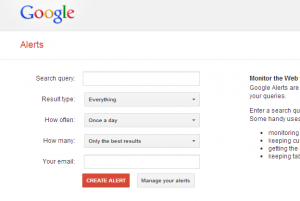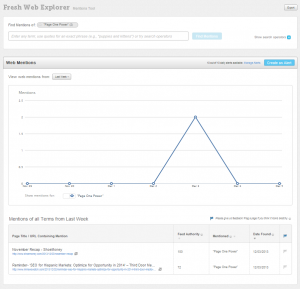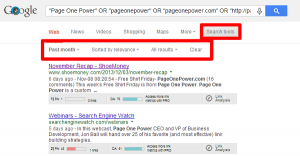Building links is a vital, yet difficult aspect of SEO. Many struggle with building even a handful of good links that make sense.
I've always said creativity is the most powerful link building tool in the world. I've always encouraged people to build links in a group environment; it’s hard to foster creativity working alone, without a sounding board, entrenched at a desk with nothing but a computer and the web.
Part of fostering creativity is engaging the right mindset. In that regard I wanted to offer 5 link building tips that will help you achieve link building success while fostering a creative mindset.
- Always monitor mentions
- Have an outreach plan
- Leverage relationships and communities
- Try something new
- Solve problems for free
Let’s take a look at each one in detail.
1. Always Monitor Mentions
This is a commonly overlooked element within a link building campaign. It’s easy for people to create a plan and follow it to the letter, forgetting to keep an eye on the bigger picture. If you’re only monitoring those you reach out to, you’re likely missing important link and campaign opportunities.
After all, if someone has already mentioned your brand, website, URL, company, product, CEO, etc. naturally and without any prompting on your behalf, it means they’re already engaged. It’s then very easy to reach out, thank them for the mention, and ask if they wouldn’t mind including a link. This could very well begin a relationship which may lead to better campaign reach and accomplishment.
You should watch all channels and monitor any mentions, links, or shares. Being aware of these mentions and being proactive can increase engagement, drive campaign momentum, and result in easy-to-capture links.
Some tools to help you stay aware and proactive:
A) Google Alerts
Google alerts is a simple tool from Google that will email you whenever your query appears on the web.
As you can see, there are 4 different fields:
- Search query
- Result type
- Everything
- News
- Blogs
- Videos
- Discussions
- Books
- How often
- As-it-happens
- Once a day
- Once a week
- How many
- Only the best results
- Everything
Google alerts can be a bit broad, but I highly recommend using it as a base tool to ensure nothing is slipping past your attention on the web. Don’t forget to use advanced modifiers in the query to ensure effective alerts.
B) Fresh Web Explorer from Moz
Fresh Web Explorer (FWE) is part of a paid subscription to Moz. If you’re already a subscribing member of Moz there’s absolutely no reason not to be using FWE – it’s a great tool that they’re continually improving. Recently they've even added email notifications, similar to Google alerts.
Furthermore, I have to say that using both FWE and Google Alerts I've found FWE to be the superior of the two tools. It’s great to be able to search in real time for mentions, and FWE also tends to dig up more legitimate mentions.
C) Advanced search in Google
Advanced modifiers in Google search can suss out unlinked mentions for those DIY, never-rely-on-tools types.
An example I might use to track my company, Page One Power:
- “Page One Power” OR “pageonepower” OR “pageonepower.com” OR “http://pageonepower.com” –site:pageonepower.com –site:twitter.com –site:facebook.com
As a bonus, don’t forget to utilize Google’s built in ‘search tools’:
Even if you do prefer tools, being proficient and efficient with Google search should be a part of every online marketer’s toolkit. There’s a wide variety of uses, from checking a website’s indexed pages, reverse engineering a competitor’s guest post campaign, to finding obscure bits of information.
D) Google Image search
When is a mention not a mention? When it’s a unique image used without accreditation.
If you have unique images on your site, or are using unique images in your campaign, you should periodically be reverse searching for these images in Google.
It’s incredibly simple to use and all it takes is a quick email to ask for a link in return for using the image – practically a freebie.
How this all helps creativity: Tracking mentions across the net will not only help you find potential link building opportunities, but can help spark inspiration based upon what’s already being said about your website or brand. Fully understanding how others perceive you online will help you create a more targeted campaign, and hopefully add a spark of creativity.
2. Have an Outreach Plan
Often inexperienced link builders hear the power of epic content and the links such content can/should earn naturally. This can unfortunately translate into the mindset of “if you build it, they will come”.
This happens for a few reasons. First, so many current SEO thought leaders are pushing content, especially big, epic, large-investment content. When you’re investing so much time, energy and resources into the content, it’s natural to believe everyone’s absolutely going to love it.
Second, it’s due to virality of the internet. Every day some new piece of content goes viral – it seems like it should be easy. But it’s not.
And finally, it’s a lack of appreciation of the noise across the web. People severely underestimate how hard it is to draw consistent attention and cut through the noise. No one can do it alone.
If you want links, social shares, mentions, or even just views to your freshly produced content, you absolutely need an outreach plan.
You should have a comprehensive plan that includes:
- Who you want to reach out to:
- Industry relationships
- Anyone involved in the content
- Anyone mentioned in the content
- Anyone who’s created similar content
- Niche influencers
- Moonshot targets
- At what stage:
- Before creation
- During creation
- Pre-publication
- Post publication
- After social proof
- Using what platforms:
- Social media
- Mutual relationships
- Phone
- How you’ll deal with:
- Positive response
- Negative response
- No response
Furthermore, you need to understand best practices for outreach, which begins with understanding your target audience.
Stephanie Beadell formerly of SEER wrote an outstanding guide to effective outreach. Definitely worth taking the time to read through if you’re gearing up for an outreach campaign.
How this helps creativity: interacting with others is one of the best sources of creativity. No one should work within a bubble, and amplification should be an ingrained step of your link building campaign. So don’t be afraid to interact with others in your industry, both as a source of creativity and a source of amplification.
3. Leverage Relationships and Communities
Being engaged in your industry is a great way to build natural links. Although not all link building requires relationships, it’s only natural to build relationships and links concurrently.
Better yet, if you are engaged in your community and building mutually beneficial relationships, you’ll have more link building opportunities. For example, being engaged in your community, you might be asked to participate in:
- Surveys
- Interviews
- Provide/receive testimonials
- Industry events
- Contributing content to their blog
- Share an experience
- Review or test a new tool
- Etc.
As I said before, with the amount of noise on the net it’s impossible to spread the word yourself. So if you want the links to roll in, you’re definitely going to need help. Participate meaningfully in the community and foster relationships and good things will happen.
How this helps creativity: again, no one should be working within a bubble. Creating relationships with other thought leaders within your industry is one of the best sources of inspiration. It’s astounding how often people are willing to share ideas or simply be a sounding board – relationships are part of being human.
4. Try Something New
It can be incredibly hard to do something new or unexpected within many industries, especially niche industries, or industries that don’t naturally garner much attention.
The great thing about the internet however is that it’s much more dynamic than other traditional and established marketing methods; there’s much more room left to experiment.
Although it can be hard to justify or even predict ROI, fresh ideas embodied in even small projects can make a big impact.
A great example of this is James Norquay’s response to Mathew Barby’s post, The 100-Dollar Link Building Challenge. In it Barby asked various SEOs how they would build links with only 100 dollars. James Norquay went above and beyond, actually attempting the challenge and reporting the results.
Although it wasn't a rousing success as far as links, you can bet it caused a bit of a stir in the community and caught the attention of everyone who participated in the challenge, helping establish Norquay as a forward thinking link builder.
How this helps creativity: Trying something new is one of the best ways to exercise your creative muscle. Don’t be afraid to experiment with different ideas – understanding the results can lead to better and more efficient link building (not to mention creative thinking).
5. Solve Problems for Free
Solving problems for free is the core of what Rand Fishkin of Moz calls “Investing in Non-Measurable Serendipitous Marketing”.
The concept is to recognize and solve a problem for a targeted group of people within your niche. If this is done consistently, eventually there will be a serendipitous, or unexpectedly large, payoff.
This shouldn't be your only strategy, as it’s unpredictable, but it’s worth spending a portion of your time in. It’s absolutely great for establishing authority and building your presence within your industry’s community. Rand recommends 20% of your time/budget be allocated into serendipitous projects.
Here’s a few ways to find a problem worth solving in your niche:
- Research content, resource, product, and tool gaps
- Ask your audience/customers questions
- Create an industry survey
- Talk to industry experts
- Create a list of persona pain points
- Watch industry forums
- Engage in social media
- Watch competitors
Try to find something that resonates – something you feel is worth solving, that will take a small or reasonable amount of time. Again, keep in mind you don’t want to sink all of your marketing resources into this – even Rand, who uses the altruistic TAGFEE code, only uses 20% of his overall budget.
And obviously, once you've helped address the problem, you should alert those who’re likely to appreciate the solution.
How this helps creativity: fixing problems within your industry will only provide better insight into your industry as a whole. One of the best ways to increase creativity is to increase overall understanding, which will help you make better, more intelligent connections.




